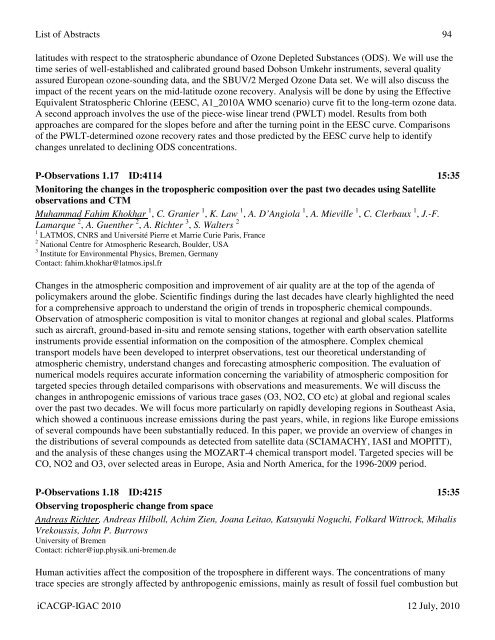Download Abstracts Here - IGAC Project
Download Abstracts Here - IGAC Project
Download Abstracts Here - IGAC Project
You also want an ePaper? Increase the reach of your titles
YUMPU automatically turns print PDFs into web optimized ePapers that Google loves.
List of <strong>Abstracts</strong> 94latitudes with respect to the stratospheric abundance of Ozone Depleted Substances (ODS). We will use thetime series of well-established and calibrated ground based Dobson Umkehr instruments, several qualityassured European ozone-sounding data, and the SBUV/2 Merged Ozone Data set. We will also discuss theimpact of the recent years on the mid-latitude ozone recovery. Analysis will be done by using the EffectiveEquivalent Stratospheric Chlorine (EESC, A1_2010A WMO scenario) curve fit to the long-term ozone data.A second approach involves the use of the piece-wise linear trend (PWLT) model. Results from bothapproaches are compared for the slopes before and after the turning point in the EESC curve. Comparisonsof the PWLT-determined ozone recovery rates and those predicted by the EESC curve help to identifychanges unrelated to declining ODS concentrations.P-Observations 1.17 ID:4114 15:35Monitoring the changes in the tropospheric composition over the past two decades using Satelliteobservations and CTMMuhammad Fahim Khokhar 1 , C. Granier 1 , K. Law 1 , A. D’Angiola 1 , A. Mieville 1 , C. Clerbaux 1 , J.-F.Lamarque 2 , A. Guenther 2 , A. Richter 3 , S. Walters 21 LATMOS, CNRS and Université Pierre et Marrie Curie Paris, France2 National Centre for Atmospheric Research, Boulder, USA3 Institute for Environmental Physics, Bremen, GermanyContact: fahim.khokhar@latmos.ipsl.frChanges in the atmospheric composition and improvement of air quality are at the top of the agenda ofpolicymakers around the globe. Scientific findings during the last decades have clearly highlighted the needfor a comprehensive approach to understand the origin of trends in tropospheric chemical compounds.Observation of atmospheric composition is vital to monitor changes at regional and global scales. Platformssuch as aircraft, ground-based in-situ and remote sensing stations, together with earth observation satelliteinstruments provide essential information on the composition of the atmosphere. Complex chemicaltransport models have been developed to interpret observations, test our theoretical understanding ofatmospheric chemistry, understand changes and forecasting atmospheric composition. The evaluation ofnumerical models requires accurate information concerning the variability of atmospheric composition fortargeted species through detailed comparisons with observations and measurements. We will discuss thechanges in anthropogenic emissions of various trace gases (O3, NO2, CO etc) at global and regional scalesover the past two decades. We will focus more particularly on rapidly developing regions in Southeast Asia,which showed a continuous increase emissions during the past years, while, in regions like Europe emissionsof several compounds have been substantially reduced. In this paper, we provide an overview of changes inthe distributions of several compounds as detected from satellite data (SCIAMACHY, IASI and MOPITT),and the analysis of these changes using the MOZART-4 chemical transport model. Targeted species will beCO, NO2 and O3, over selected areas in Europe, Asia and North America, for the 1996-2009 period.P-Observations 1.18 ID:4215 15:35Observing tropospheric change from spaceAndreas Richter, Andreas Hilboll, Achim Zien, Joana Leitao, Katsuyuki Noguchi, Folkard Wittrock, MihalisVrekoussis, John P. BurrowsUniversity of BremenContact: richter@iup.physik.uni-bremen.deHuman activities affect the composition of the troposphere in different ways. The concentrations of manytrace species are strongly affected by anthropogenic emissions, mainly as result of fossil fuel combustion butiCACGP-<strong>IGAC</strong> 2010 12 July, 2010








